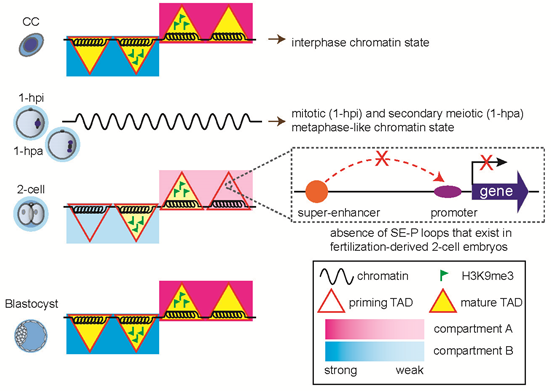On April 14, 2020, a paper entitled " Chromatin architecture reorganization in murine somatic cell nuclear transfer embryos" was published on Nature Communications (IF=11.878) by Prof. Shaorong Gao's and Cizhong Jiang’s group. They generated a high-resolution map of 3D chromatin structure across consecutive stages of SCNT embryo development and revealed the regulatory mechanism of zygotic gene expression controlled by higher-order chromatin reorganization.
It is well recognized that somatic cell nuclear transfer (SCNT) provides the only way to reprogram somatic cells into totipotent embryos and generate viable animals. Although various cloned animals, including amphibians and mammalians, can be generated, the efficiency of SCNT-mediated cloning remains extremely low. Aberrant epigenetic modifications, including 3D chromatin structure, were major barriers that prevent successful reprogramming in SCNT embryos. However, the spatiotemporal chromatin organization of SCNT embryos remains elusive. In this paper, prof. Gao and colleagues examined the higher-order chromatin structures of mouse SCNT embryos using a low-input Hi-C method. They found the donor cell chromatin transforms to metaphase state rapidly after SCNT along with the dissolution of typical 3D chromatin structure. Intriguingly, the genome underwent a mitotic metaphase-like to meiosis metaphase II-like transition following activation. Subsequently, weak chromatin compartments and topologically associating domains (TADs) emerge after metaphase exit. TADs are further removed until the 2-cell stage and are then progressively reestablished. Obvious defects including stronger TAD boundary and aberrant super-enhancer and promoter interactions are found in SCNT embryos. These defects are partially caused by inherited H3K9me3 and can be rescued by Kdm4d overexpression. Therefore, this study provided a high-resolution map of how the mature 3D chromatin structure of somatic cells is reprogrammed to a totipotent state after transplantation into enucleated oocytes.

Figure 1. Summary of the paper content
Dr. Shaorong Gao, Dr Cizhong Jiang and Dr. Xiaoyu Liu from School of Life Sciences and Technology at Tongji University are the co-corresponding authors. PhD students Mo Chen and Qianshu Zhu, and associate professor Dr. Chong Li are the co-first authors. This work was supported by the funding provided by National Key R&D Program of China and the National Natural Science Foundation of China.